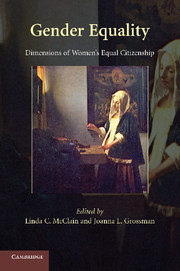Book contents
- Frontmatter
- Contents
- Contributors
- Acknowledgments
- Gender Equality
- Introduction
- PART I CONSTITUTIONAL CITIZENSHIP AND GENDER
- PART II POLITICAL CITIZENSHIP AND GENDER
- 6 Women and Antiwar Protest: Rearticulating Gender and Citizenship
- 7 Stem Cells, Disability, and Abortion: A Feminist Approach to Equal Citizenship
- 8 Representation, Discrimination, and Democracy: A Legal Assessment of Gender Quotas in Politics
- 9 Citizenship and Women's Election to Political Office: The Power of Gendered Public Policies
- PART III SOCIAL CITIZENSHIP AND GENDER
- PART IV SEXUAL AND REPRODUCTIVE CITIZENSHIP
- PART V GLOBAL CITIZENSHIP AND GENDER
- Suggested Readings
- Index
- References
6 - Women and Antiwar Protest: Rearticulating Gender and Citizenship
Published online by Cambridge University Press: 05 August 2012
- Frontmatter
- Contents
- Contributors
- Acknowledgments
- Gender Equality
- Introduction
- PART I CONSTITUTIONAL CITIZENSHIP AND GENDER
- PART II POLITICAL CITIZENSHIP AND GENDER
- 6 Women and Antiwar Protest: Rearticulating Gender and Citizenship
- 7 Stem Cells, Disability, and Abortion: A Feminist Approach to Equal Citizenship
- 8 Representation, Discrimination, and Democracy: A Legal Assessment of Gender Quotas in Politics
- 9 Citizenship and Women's Election to Political Office: The Power of Gendered Public Policies
- PART III SOCIAL CITIZENSHIP AND GENDER
- PART IV SEXUAL AND REPRODUCTIVE CITIZENSHIP
- PART V GLOBAL CITIZENSHIP AND GENDER
- Suggested Readings
- Index
- References
Summary
Introduction
Law, like many other disciplines, has seen a recent rekindling of interest in questions of citizenship. Debates about immigration, about the meaning and obligations of American citizenship post-9/11, and about the domain of citizenship in a world shaped by both ethnic nationalism and the forces of globalization have given this familiar topic new salience. Yet paradoxically, protest – a dimension of citizenship that these debates have inspired – has not been systematically revisited. In this chapter, I consider protest as an activity of citizenship by analyzing its practice in a particular context: the waging of war. I also analyze such protest, as it has been undertaken by women, acting as women. This focus holds intrinsic interest to me, as a feminist scholar. However, focusing on the activity of a specific group of citizens – particularly one that has historically sustained a vexed relationship to citizenship – is consistent with the emerging theoretical framing of citizenship as a status and activity that is both differentiated and differentiating.
I will examine these questions through the lens of three recent antiwar movements led by women: Cindy Sheehan's Camp Casey vigil and related activism, CODEPINK for Peace, and Women in Black. Each of these groups has mobilized aspects of gender that have historically been offered as justifications for resisting war. Yet they have rearticulated these dimensions of gender to respond to a context in which the stakes are simultaneously lower and higher than in previous periods and few women subscribe to simple, unitary conceptions of motherhood or the relationship between women and peace.
- Type
- Chapter
- Information
- Gender EqualityDimensions of Women's Equal Citizenship, pp. 131 - 153Publisher: Cambridge University PressPrint publication year: 2009
References
- 1
- Cited by

